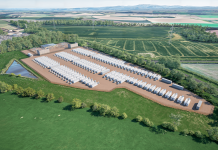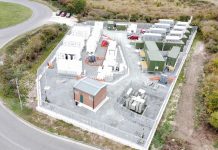Centrica is working to build a viable system to enable local energy balancing and trading, involving small businesses and households. Its test bed is Cornwall.
Whereas other platforms are trying to match buyers and sellers of flexibility, Centrica has bigger plans – if it can prove its model works.
Flexible approach

The local energy market plan involves two streams. First is a ‘quote and tender’ model, where “Western Power Distribution will place a bid onto the platform and sellers will place offers. WPD can review the offers and then make a commercial decision on whether to contract with those assets,” says Cornwall Local Energy Market product manager Sam Wevers.
That is the relatively straightforward aspect, and other companies are working towards broadly similar platforms.
The second is a more complex model, aiming to deliver a pay as cleared market-based mechanism for flex procurement by multiple parties, rather than tendering.
A key aspect is to ensure the platform neither violates substation headroom nor creates conflict between network operators and system operators, rules Centrica has been working on with National Grid and WPD for more than a year.
Assets required
The plan is to run auctions from three months out to intraday, giving buyers and sellers some flexibility on bids and buys. Centrica is keen to engage with all parties to ensure liquidity.
The product is “intentionally a broad church” to maximise participation, says Wevers.
Asset requirements are a 20-minute response time with delivery in half hour blocks. “Essentially constraint management type capabilities, not the kind of requirements demanded for frequency response, for example,” Wevers explains.
That could be batteries, CHP, biodiesel gensets, industrial load, “any demand or generation asset that can be flexible – we are tech agnostic”, says James Atkinson, energy engineer and commercial analyst for the LEM.
Local trial, international scope?
Unlocking assets capable of managing constraints will be necessary as heat and transport electrify, increasing congestion on low voltage networks, says Wevers.
“So that’s our aim: to work out how to enable distributed energy resource to access national markets in a way that doesn’t conflict with local substations.”
“But we have to get it right in Cornwall first,” stresses Wevers. “We need to take one step at a time. At this stage the focus is on bringing new projects on board, growing the footprint – and being able to show other interested parties a working model.”
Part of the challenge is technical, particularly low voltage network data. The other is commercial and setting out rules everyone can agree on.
“This is a new market model. We are trying to do things in reality that have only been talked about in abstract. Taking Beis policy goals and putting them into a platform is tricky, as is building a platform and coming up with the clearing engine. It is hard and we don’t have all the answers,” says Wevers. “But that’s why it is fun.”
The potential prize is also worth the effort, he adds. “We’re trying to see how a multisided market for flexibility services might work in the UK – and how different types of prosumers, aggregators, suppliers, and generators might be able to play in that market,” he says.
“There are very few, if any, projects doing that at this level of complexity. It is an opportunity is to see how the energy market might look in the next few years: All different types of actors playing in a single platform that is efficient, transparent and drives value for consumers and the system.”
Enabling flex connections
As part of the project, which is co-funded by the European Regional Development Fund, Centrica has installed 100 residential batteries, which will provide flex into the local market. It has also installed flow batteries (relocated from a previous project) at a working farm in order to store and shift power from its 250kW PV array.
There is also potential for Cornwall Council to install a battery adjacent to the former Wave Hub site, a socket for testing wave energy devices that did not materialise as anticipated, but which has a 30MW export agreement with WPD. The council has consent for up to a 5MW battery and is in commercial discussions with Centrica.

Should it go ahead, the battery – located at one of the most constrained parts of the network – would be able to wrap £189/MWh red band credit from WPD into its revenue stack, according to James Atkinson. “I think that is the highest in the UK, so the battery would provide some really useful services from day one.”
Atkinson says if the battery – and the broader trial – can prove that DNOs can use flex to alleviate constraints, allowing more people to connect to the network, “they can start to offer non-firm connections as business as usual”.
“As soon as they have that proof point and you have this liquid market, instead of spending millions or billions to upgrade their substations, they can pay people to use the network in a smarter way.”
That approach could deliver “huge” cost savings, says Atkinson, “if and when we can prove it”.
Making SMEs part of the future grid
As part of the trial, Centrica has been engaging local businesses, auditing their energy consumption, assessing potential to provide flex and installing new kit where applicable.
The Carbis Bay Hotel in St Ives, for example, is part of the trial and has installed two 35kWe CHP units – which provide heat and power to the 46-bedroom hotel, its swimming pool, plus 17 self-contained cottages and eight new luxury lodges.
Dan Allister, the hotel’s senior marketing and development manager, says it needed to centralise heat infrastructure instead of “bolting on” boilers as the site expanded. Even with the new lodges, the energy centre is expected to reduce the hotel’s energy bill by £30k/year, cut maintenance bills and save 70 tonnes of carbon per annum.
The carbon aspect is increasingly important for the hotel’s marketing, says Allister. “But not just as a PR exercise,” he says, adding guests who may be paying £1,000 a night to stay in beachfront lodges increasingly care about environmental credentials, “so sustainability is very important to us”.
Allister says there are other benefits. “The local grid supply is poor. We have suffered outages – and this gives us the opportunity to get some resilience and consistency,” he says.
The set-up also enables the hotel to feed surplus electricity back into the local market as of this summer. Allister is comfortable with the requirements of becoming a flexible energy provider and says the experience from Centrica’s trial will help shape its involvement in future smart grids.
A licence to save money

Printing firm Deltor Communications is also part of the trial. Managing director Sam Shannon says clients are increasingly environmentally focused, driving the company to cut its carbon footprint wherever possible. Moreover, the firm is ISO14001-certified, which requires continuous improvement.
“We heard funding was available as part of the trial, applied to take part and Centrica came in and installed its Panoramic Power monitoring system,” says Shannon.
The system, which involves clip on sensors and analytics, highlighted inefficiencies in Deltor’s operation, and helped justify investment in a variable speed compressor. It also helped the company to identify and fix air leaks throughout the factory, plus equipment that was drawing power unnecessarily.
“That created big savings, particularly the air leaks, because we were basically bleeding money,” says Shannon. Once those losses were quantified in financial terms, the investment decision was easy, he adds.
As a result, Shannon says the company has reduced power consumption by 11 per cent. “Compressed air was our biggest draw, about 50 per cent of the businesses’ consumption. It’s huge, so the variable speed compressor has made a massive difference for us. We have actually installed another huge press and not seen any rise in energy bills, because one has counteracted the other. So for customers, per sheet of paper, we have reduced its carbon footprint. And we are using the savings to fund growth.”
Shannon says payback on the compressor is “ridiculously quick, a year and a half”.
Quantifying credentials
The company’s clients include the Houses of Parliament, the Eden Project, universities and local councils, for whom sustainability credentials affect business decisions. “We want to tell clients we are the greenest printers in the South West,” says Shannon. “We believe we are – and we can quantify that. If the University of Exeter comes to us and wants to know the carbon footprint of its prospectus, we can tell them – not many others could.”
The company also uses the Panoramic Power app to monitor generation from its 120kW rooftop PV. Shannon says investing in battery storage is next up for consideration.
“We would love to do that, or another form of generation. We use all the energy we make [via PV]. We operate 24/7 but most of our workforce are in during peak demand – and that is costly.”
This article appears in The Energyst’s June/July print issue. If you have some responsibility for energy procurement, management or sustainability for your organisation, you qualify for a free subscription.
Related stories:
Energy Institute: Local energy systems key
All DNOs commit to considering flex over reinforcement
SSE to deploy flex across entire network, down to household level
All DNOs trialling Piclo platform
Follow us at @EnergystMedia. For regular bulletins, sign up for the free newsletter.




Interesting. If there is limited capacity in an area then it must be pay as bid as they have a constraint to manage and they also need to understand the real value of capacity. If its higher than build costs then they should build.